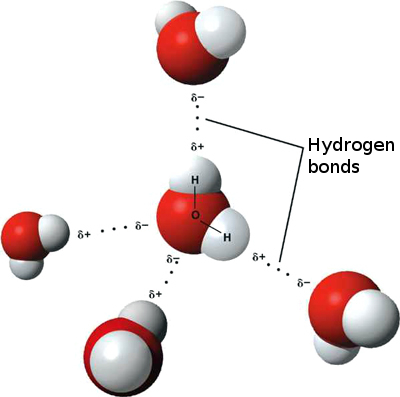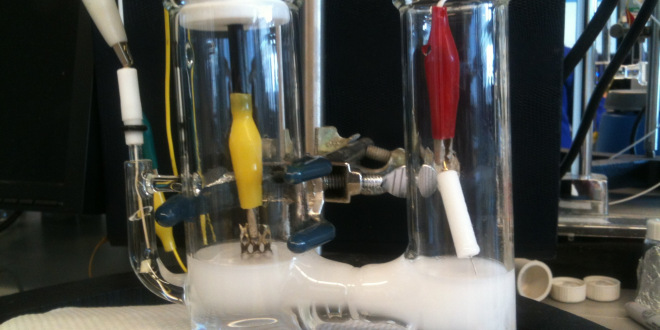I know it is April 1 and the traditional day for publishing a nonsense or “non-science” article.
But this is not one of them. So no April Fools.
Two chemistry professors, Curtis Berlinguette and Simon Trudel, at the University of Calgary have published a paper in the journal Science in the last week in which they describe their discovery, a low-cost catalyst that can split water into hydrogen and oxygen. The catalyst contains a combination of iron, cobalt and nickel which when exposed to a light source decomposes the water into its base components.
The professors have formed a new start up company, FireWater Fuel, to commercialize their invention. On their website they tell the story of the value of hydrogen as an energy source, that is, a single kilogram of hydrogen contains three times the energy of an equivalent amount of gasoline. So it makes sense to be looking at hydrogen even though up until now the cost of releasing that energy has always been prohibitive.
That’s why FireWater’s invention is so significant. The catalyst is cheap to produce and has significant potential for use in many different applications.
Initially the company intends to produce an electrolyzer that generates hydrogen for energy storage that when combined with wind farms or solar power arrays will provide storage to support continuous energy production when the wind doesn’t blow or the Sun doesn’t shine.
FireWater also sees its technology as useful for inexpensive hydrogen fuel cells in electric vehicles.
It can also be used to convert sequestered CO2 into liquid fuels.
A freezer-sized electrolyzer trademarked under the name FFCat is planned for release on the market in 2015. The electrolyzer will convert a few liters of water per day into electricity for domestic consumers. Is this the beginning of the hydrogen revolution? Maybe. We’ll keep watching and reporting.











((Is this the beginning of the hydrogen revolution?))
Not based on anything in your article. This seems a good April Fool’s offering. Probably no aspects of wind and solar power have been more exhaustively explored than hypothetical methods of storing the energy. Electrolysis of water is, of course, near the top of the list. The iron laws of physical chemistry argue that regardless of even the most ideal catalyst employed, more energy will be required to break the hydrogen out of the water molecule than will be released when the hydrogen is subsequently oxidized. The hydrogen in the methane molecule, CH4, is much more loosely bound than the hydrogen in the water molecule. That’s why methane is a fuel and water is not. Most hydrogen is produced through steam reforming of methane (natural gas). The steam reforming process requires only 10% as much energy per unit of hydrogen produced (about 10% of the natural gas in the reforming process stream burns to drive the process). The cost and availability of hydrogen at a production facility is a trivial factor retarding the widespread use of hydrogen as an energy source.
To compound the difficulties of using electrolytic hydrogen as an energy storage medium, is the fact that storage and transportation costs for hydrogen is probably ten times greater than for methane.
I’ll grant that even the most efficient, and correspondingly high capital cost, electrolytic methods of breaking hydrogen out of water don’t exceed 40% efficiency. (The US DOE has already invested millions into methods of producing hydrogen with fission reactors, but fractured shale natural gas production has mostly rendered those efforts moot.) Even if electrolysis were 100% efficient, it wouldn’t make much difference in overall energy economics. If pure hydrogen were in great natural abundance and could be produced like natural gas for about $2.25 mmbtu, it couldn’t compete with crude oil and natural gas. The Firewater project will either collapse under the weight of its intrinsic physical inefficiencies, or worse, turn into another wasteful government subsidized boondoggle.
Thanks for your insight. As a layman who has an interest in hard science and technological advancement my question to you is this:
Why do so many credentialed people announce these incredible discoveries and technological breakthroughs when most turn out to be lame?
Is this an ego thing or do they actually believe they have made a eureka discovery?
((Why do so many credentialed people announce these incredible discoveries and technological breakthroughs when most turn out to be lame?
Is this an ego thing or do they actually believe they have made a eureka discovery?>>
For every announcement of incredible discovery there must exist some particular set of motivations. Sure in most instances some amount of ego plays a role. More likely it’s akin to the same reason that people buy lottery tickets. The gamblers know their odds of winning are poor, but they are infinitely better than those whom refuse to buy tickets.
Also, in most instances where seriously credentialed individuals are involved, the published papers are in fact technically valid. But the published papers don’t seriously address markets and commercial viability. One shouldn’t dismiss the impact of other developments unknown to the announcers.
The subject “breakthrough” probably results from over a decade of research, and academic careers were invested in it. The researchers are physical chemists, and they certainly understand they don’t exactly have a eureka world shaking discovery.
In the year 2000 very few people could have responsibly predicted huge reserves and production of cheap natural gas from fractured shale. But in the year 2000 it was obvious that exploitation of Alberta’s huge reserves of tar sand required huge amounts of hydrogen for “upgrading” tar into motor fuel. If natural gas reserves dwindled and costs rose too high, Alberta’s tar sand would prove worth little or nothing. Alberta’s boom economy was hostage to hydrogen, traditionally supplied by natural gas. So a number of engineers and scientists, myself among them, began considering and exploring alternatives to natural gas for the tar sand upgrading plants. Many schemes for using small fission reactors in Alberta to melt tar out of the sand in situ, produce process heat, and provide electrolytic hydrogen for the upgrade plants were proposed to keep the motor fuel flowing out of the Athabasca region. The U. of Calgary researchers shared the common misconception in 2000, as I did, that natural gas production costs would continue to rise as reserves dwindled. By 2005 evidence was mounting that natural gas reserves were very much greater than projected in 2000. But the efficient electrolysis researchers were caught in a cruel “prior investment trap.” They were working on a technology that markets wouldn’t support for many decades, but they could only go forward and try to find some uncommon problem their honest solution would solve. And all the while more natural gas reserves were coming on line.
Their “solution” will only have significant value in locations where natural gas is unavailable or too costly. One should note that in regions with large coal reserves and abundant water, it’s technically feasible to combine raw hydrogen with coal and produce high quality motor fuel. So one could envision North Korea, for example, burning coal to produce electricity for the disassociation of water to be used to produce synthetic motor fuel. In which case the N.K. engineers would be seeking the most efficient technology for electrolysis. Since N.K couldn’t care less about its contribution to atmospheric carbon, more likely it would go for a direct coal to liquids modified Fischer-Tropsch process such as China presently employs in its large Mongolian plant.
So the utility of the best electrolysis catalyst really boils down to whether storing solar and wind energy on site in the form of hydrogen is cheaper than batteries, or pumped hydro storage, or compressed air, etc.